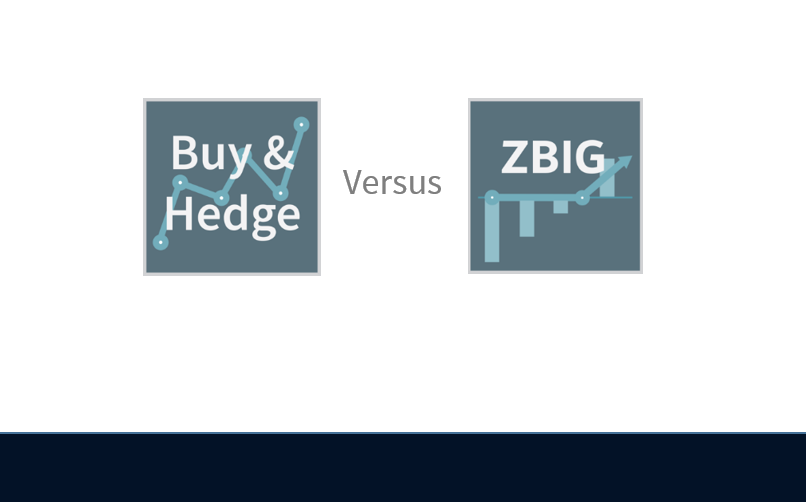
What Flavor Do You Prefer? Portfolio Floors or Buffers?
By Derek Moore
August 5, 2021
Differences Between Buy and Hedge Retirement and ZEGA Buffered Indexed Growth Strategies (ZBIG)
From time to time I like to write an article that answers some frequent questions we get on our strategies. I’ve had this one on deck for a while. The question usually goes something like “ So tell me again what it means to have a floor vs. a buffer”? The question is referring to the difference in our two strategies Buy and Hedge Retirement vs. ZBIG (ZEGA Buffered Indexed Growth).
We will go through some of the nuances and differences and towards the end, I’ll include a table that highlights at a glance points.
Buy and Hedge Retirement

- Risk graphs represent equity risk taken compared to the S&P 500 Index
With both strategies, we utilize long call options to create notional exposure where we control but do not own shares of the S&P 500 Index.
Long calls can only lose what we paid for them. Since we only use a fraction of the account to purchase these calls, we can define the dollars at risk associated with the stock market. So if we only spend 8% of an account’s value to purchase calls, we know that 8% is the most we can lose if the market fails to go up.
For the Buy & Hedge Retirement strategy typically design is to not lose more than 8% to 10% in any 12-month period. We then use short-duration fixed income (that also is hedged) to fund some of the cost it took to purchase the long option. The short-duration high yield risk is hedged using options to reduce the downside as well.
So when we say there is a floor below the market of 8% to 10%, it means that your clients will feel that first percentage dropdown, but not below that. This strategy is designed for those that are looking to limit the downside with defined risk levels. The give-up is that it is designed to only capture around 70% to 75% of the upside.
The exception is where the markets materially selloff as they did back in February and March of 2020 where we can use the avoided loss or hedging profits to reinvest into more notional shares and potentially capture more of the rebound. We refer to this as the hedgers' opportunity. In these cases, there is the opportunity to capture a greater percent or more than the S&P 500 Index.
So you only lose the first 8% to 10% drop, but then avoid losses below that and, then the hedgers’ opportunity may kick in.
ZEGA Buffered Indexed Growth (ZBIG)
Our ZBIG strategies come in three versions: Leveraged, Standard, and Retirement.

The difference here is that unlike a defined floor in the equity risk, your clients have a buffer where they won’t experience the first move down in the S&P 500 Index, but then will feel it beyond that buffer and start to track more along with the performance of the index. While this seems like a better way to protect, there is a trade-off (by the way, it seems there is always a trade-off). ZBIG is more of a maturity-based product and requires 18-36 months of commitment to realize the buffer. That is not the case for Buy & Hedge.
Where the risk comes into play is ZBIG also carries short-duration high yield risk that with some exceptions is unhedged. At times we do use spreads on high-yield as a substitute that does have some risk limitations. The scope of that is beyond our topic here today though.
You can see the risk graphs for the equity portion above. So think of this as mitigating the early risk but then at some point, you will experience drawdowns if the market selloffs are material enough. On the ZEGA website under our strategies, we have extensive presentations and historical performance tear sheets for all our strategies to learn more.
While each client’s use case differs, something like ZBIG Leveraged may not be appropriate depending on risk levels right before or early into retirement for substantial portions of portfolios. Where individual clients are nearing or in retirement, Buy and Hedge Retirement or ZBIG IRA may be a better flavor to borrow from my title.
Comparing Strategies
Strategy | Type of Risk Mitigation | Target Capture of S&P 500 Index Upside | Fixed Income Risk Type | Max Loss on Equity Exposure Only | Designed Holding Period |
Buy & Hedge Ret | Floor After First 8-10% Down | 70 – 75% | Hedged Short Duration High Yield | 8 – 10% | Unspecified |
ZBIG Leveraged | Buffer on First 25% Down | 120 – 140% | Un-Hedged Short Duration High Yield | 40% | 18 – 36 Months |
ZBIG Standard | Buffer on First 25% Down | 90 - 110% | Un-Hedged Short Duration High Yield | 10% | 18 – 36 Months |
ZBIG IRA | Buffer on 100% Down | 65 – 85% | Un-Hedged Short Duration High Yield | 0% | 18 – 36 Months |
Note* Estimates on Downside Risk Represent Equity Losses Only. High Yield Fixed Income Losses May Vary Where Total Return May Be Impacted by Monthly Dividends and Changes In Market Values
As you see with the ZBIG Strategies, you are swapping equity risk for short-duration high yield. Each of these offers different features and benefits that can help map as an alternative to your client's current investment strategies.
If you are not using one of our hedged equity strategies yet and want to learn more, reach out to us to set up a meeting. If you are, thank you, but have questions contact us to help with the use case for each of these.
